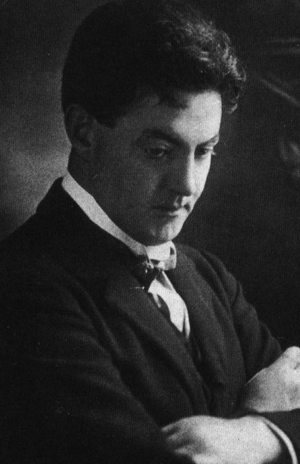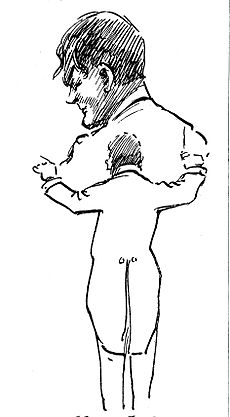Hamilton Harty facts for kids
Sir Herbert Hamilton Harty (born December 4, 1879 – died February 19, 1941) was a famous Irish musician. He was a composer, conductor, pianist, and organist.
Harty started his career playing the organ in churches in Ireland. When he was about 20, he moved to London and quickly became a top piano accompanist. People even called him "the prince of accompanists" because he was so good at playing along with soloists. He also wrote many musical pieces throughout his life. While some of his works were very popular back then, not many are played often today.
Later in his career, Harty became a conductor, starting in 1904. He was especially known for conducting the music of Hector Berlioz. From 1920 to 1933, he was the main conductor of the Hallé Orchestra in Manchester. He helped this orchestra become one of the best again, just like it was under its founder, Charles Hallé. His last main job was with the London Symphony Orchestra, but it only lasted two years (1932-1934). Harty also made several recordings with the orchestras he conducted. Sadly, he developed a brain tumour shortly after leaving the LSO. He had surgery and continued working until 1940, but the tumour returned, and he passed away at age 61.
Contents
Harty's Early Life and Music Career
Growing Up in Ireland
Hamilton Harty was born in Hillsborough, County Down, Ireland. He was the fourth of ten children. His father, William Michael Harty, was a church organist, and he taught young Hamilton to play the viola, piano, and how to compose music. By the age of 12, Harty followed in his father's footsteps and became an organist at a church in Magheragall, County Antrim. He continued to work as a church organist in Belfast and Bray during his teenage years. In Bray, he met Michele Esposito, a piano professor, who encouraged him to become a piano accompanist. Being close to Dublin, Harty was able to hear an orchestra perform for the first time, which was a big moment for him.
Becoming a Musician in London
Around 1900 or 1901, Harty moved to London to further his music career. He quickly became known as both a promising composer and an amazing piano accompanist. The Musical Times newspaper even called him "the prince of accompanists." Some of his early compositions included a Trio (1901), a Piano Quartet (1904), and the Comedy Overture, which was first performed at the Proms in 1907.
On July 15, 1904, Harty married a famous singer named Agnes Nicholls. In the same year, he conducted for the first time. He led the Dublin Orchestral Society in Dublin for the first performance of his own piece, Irish Symphony. Critics praised the symphony, calling it "a work of much promise." Over the next few years, Harty continued to compose. Important works from this time include his setting of John Keats's poem "Ode to a Nightingale" (1907), a Violin Concerto (1908), the tone poem With the Wild Geese (1910), and the cantata The Mystic Trumpeter (1913).
Harty got his first big conducting job in London thanks to his wife's connections. He conducted the London Symphony Orchestra (LSO) in March 1911, performing his piece With the Wild Geese. This performance was very successful, and he was invited back to conduct the LSO again. However, his next concerts with the LSO were not as popular with critics or the public. He also conducted operas like Tristan und Isolde and Carmen at Covent Garden in 1913. But he later admitted that he didn't really enjoy opera, saying it felt like music was getting in the way of the story.
Leading the Hallé Orchestra
Harty returned to conducting orchestral music. In April 1914, he made his first appearance with the Hallé Orchestra in Manchester. During the First World War, he joined the Royal Naval Volunteer Reserve and served in the North Sea. After the war, he rejoined the Hallé Orchestra, stepping in for Sir Thomas Beecham to conduct famous works like Handel's Messiah. Critics noticed that Harty had much better control over the orchestra and praised his skill.
In 1920, Harty was chosen to be the permanent conductor of the Hallé. Under his leadership, the Hallé Orchestra became one of the best orchestras in England, just as it had been under its first conductors, Charles Hallé and Hans Richter. Harty was also excellent at conducting concertos, which are pieces for a solo instrument and orchestra. He was so good that soloists like Wilhelm Backhaus wished they could take the Hallé Orchestra with them on their tours! Once, during a Brahms concerto, the soloist Artur Schnabel accidentally skipped two bars of music. But Harty and the Hallé Orchestra were so in sync that they kept playing perfectly with him. Schnabel was amazed and said he'd never experienced such wonderful accompaniment.
Harty introduced many new pieces and composers to the Hallé audiences. He loved the music of Hector Berlioz and often included his works. He also performed music by modern composers like Bax, Moeran, Sibelius, Richard Strauss, and Walton. Some of the most important performances during his time with the Hallé included the first English performances of Mahler's Ninth Symphony (1930) and Shostakovich's First Symphony (1932). As a composer, Harty became famous for his grand arrangements of Handel's Water Music and Music for the Royal Fireworks. In 1925, he was made a knight, so he became "Sir" Hamilton Harty.
Later Years and Legacy
Leaving the Hallé and Health Challenges
In 1932, Sir Hamilton Harty accepted a new job as artistic adviser and chief conductor of the London Symphony Orchestra. The Hallé Orchestra committee felt that this new role would take too much of his time away from them, so they decided not to renew his contract when it ended in 1933.
Harty was upset by how the Hallé committee announced their decision. In response, he encouraged eight of the Hallé's best musicians to join the London Symphony Orchestra, which needed new players. However, Harty's concerts in London didn't attract large audiences, and the LSO "brutally" let him go in 1934.
In the spring of 1934, Harty traveled to Australia by ship. During this trip, he met a young woman named Lorie Bolland and developed strong feelings for her. He even wrote two piano pieces for her: Spring Fancy and Portrait. These pieces show a private part of his life that was only discovered much later in 2010.
In 1936, Harty's health began to decline. He was diagnosed with a serious brain tumour. Doctors were able to remove it, but he lost his right eye during the surgery. In 1937 and 1938, Harty recovered in Ireland and Jamaica. He used this time to start composing again. He set five Irish songs to music and wrote his last original piece, the tone poem The Children of Lir. He returned to conducting in May 1938 and appeared in London again in March 1939, conducting the first performance of The Children of Lir. He conducted many concerts during the 1939–40 season, but his health worsened as the cancer returned. His last public performance was in December 1940.
Sir Hamilton Harty and his wife had separated. He was cared for by his secretary and close friend, Olive Elfreda Baguley, during his final illness. He passed away in Hove at the age of 61. His ashes were buried in the church grounds in Hillsborough, where he was born.
Recordings and Musical Works
Sir Hamilton Harty's conducting was captured in many recordings. These include famous pieces like The Rio Grande, Walton's First Symphony, and works by Berlioz and Elgar. He also conducted a very popular 1929 recording of Nymphs and Shepherds with the Manchester Children's Choir, which was played on the radio for many years.
While most of Harty's own compositions are not performed regularly in concerts today, all of his orchestral works have been recorded. Many of his other pieces, including piano and vocal works, have also been recorded in recent years, allowing new audiences to discover his music.
Selected Works
|
|
See also
 In Spanish: Hamilton Harty para niños
In Spanish: Hamilton Harty para niños



